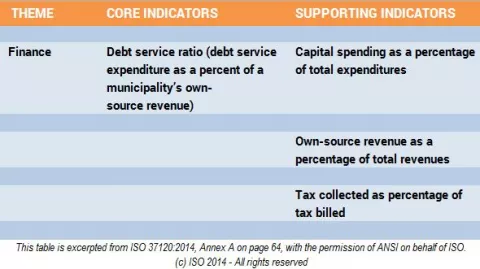
By George Karayannis, LEED AP
We continue our series on the new ISO 37120 Smart City standard with a look at the fifth of 17 themes defined in the standard – finance indicators. As previously described, ISO 37120 includes 46 ‘Core’ (must report) and 54 ‘Supporting’ (should report) indicators. The finance theme has one Core and three Supporting indicators.
Building and maintaining city infrastructure can be tremendously expensive. Street-related upgrades alone can cost $16 million or more per mile, according to the Washington State Department of Transportation. Meanwhile, a recent study estimates that New York City needs to spend $47.3 billion over the next four or five years just to bring its decrepit infrastructure to a state of good repair - plus an additional $20 billion to increase resiliency for extreme weather events.
Most cities cannot afford the cost of infrastructure upgrades, especially those with high debt levels. Detroit is one extreme, but not isolated, example of cities struggling under mountains of debt. In 2013 it owed $18 billion and became the largest U.S. city ever to declare bankruptcy.
Debt isn't a challenge unique to U.S. cities. Rome narrowly averted bankruptcy this spring and the Bank for International Settlements reported in May that global debt exceeds $100 trillion. ISO 37120 Finance indicators focus on a city’s debt, revenue and capital spending levels.
“Cities around the world are looking to upgrade their infrastructure to improve the quality of life for their citizens, and to become more competitive in attracting new jobs and residents in the process,” said John H. McCulloch, Senior Vice-President of National Standard Finance, a global infrastructure investment firm. “Having globally recognized standards for financing indicators such as ISO 37120 provides will help city leaders and investors better assess the investment risks and support infrastructure upgrades,” he added.
Let's take a look at what the new smart city standard says about city finances.
Core Indicators
1. Debt service ratio.
Municipal bonds play a very important role in the national economy by providing operational financing and allowing municipalities to undertake infrastructure upgrades. The ability of a city to repay its debt is an important indicator of its fiscal health. Unlike some industry definitions, ISO 37120 calculates debt service expenditure as a percentage of a municipality’s own-source revenue and not total expenditures.
In general, debt service ratios exceeding 20% are considered a warning signal for municipalities and a ratio of 10% or less is considered acceptable. It is important to note that debt service ratios by themselves don’t tell the whole story. High debt service ratios can mean excessive debt or an aggressive approach to debt repayment, just as low debt service ratios can mean financial stability or a lack of necessary infrastructure investment.
Supporting Indicators
1. Capital spending as a percentage of total expenditures.
A city’s capital spending plan reflects its long-term investment in fixed assets with multi-year benefits, including buildings, bridges, transit systems, and water distribution and treatment plants. Costs of maintaining and upgrading capital assets are not included since they are included in annual operational budgets. Direct comparisons of capital spending across cities can be of limited value because of the lumpiness of the investment timing, and because some municipalities place a greater responsibility for capital outlays on private developers. To offset the impact of large and infrequent capital expenditures it may be most helpful to average this indicator over several years.
2. Own-source revenue as a percentage of total revenues.
This indicator reflects a city’s financial self-sufficiency, viability and control over its own resources. Factors influencing a city’s ability to finance its own expenses include the health of its school district, the city’s ability to grow its local tax base, and historical patterns of aid programs established by state and federal legislatures. In the U.S., state aid funds nearly a third of local government budgets on average. This support has been declining in the past several years due to lower state revenues from a weak economy, forcing cities to raise service fees and seek new sources of revenue through public-private partnerships.
3. Tax collected as percentage of tax billed.
This indicator measures a city’s financial management effectiveness and its citizens' willingness to pay taxes. Since tax collection is typically the primary source of revenue for cities, collecting taxes owed is essential for cities to provide essential services. In 2012, nearly half of the owners of Detroit's 305,000 properties failed to pay a total of $246.5 million in taxes, exacerbating a punishing cycle of declining revenues and diminished services for a city in a financial crisis. At the country level, Russia and Brazil have the highest percentage of uncollected taxes at 43.8% and 39% respectively.
###
George Karayannis has over 25 years of emerging technology and complex solutions sales, business development and marketing experience and has held leadership positions at Schneider Electric, Lockheed Martin Energy Solution, AT&T and wireless sensor startups. He has also served as a city councilman and is restoring a 100-year old opera house to LEED Gold status. @gkarayannis
Next in the series: Fire and emergency response indicators for smart cities
Previously in the series:
- Dissecting ISO 37120: Why this new smart city standard is good news for cities
- Dissecting ISO 37120: Economic indicators in the new smart city standard
- Why education may be the most important smart city indicator of all
- What the new smart city standard says about energy
- Does your city's air quality measure up to the new smart city standard?



